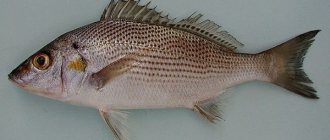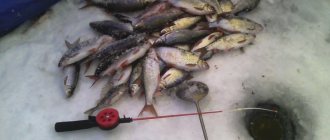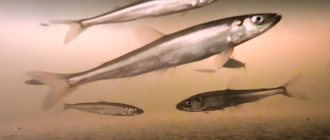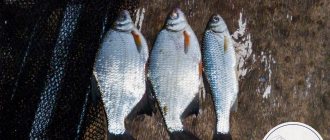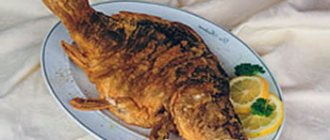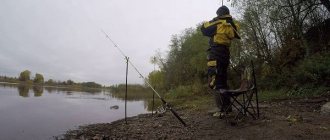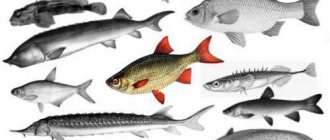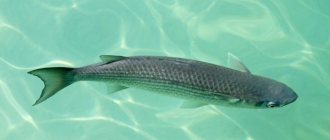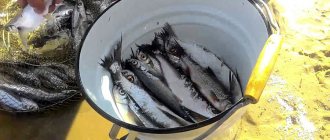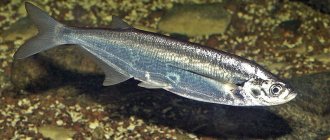Chekhon
in appearance it cannot be confused with any other. For its original appearance, the sabrefish received many names - herring, cleaver, saber, mower and others. Chekhon is a delicious fish. It is highly valued by lovers for its fatty and tender meat. Chekhon is usually consumed dried, salted and smoked. However, in many areas of its habitat, fishing for saberfish is prohibited and is under environmental protection, since due to numerous fishing activities, the number of fish has begun to decline sharply.
Description
Chekhon
Chekhon (from the Latin Pelecus cultratus) belongs to the carp family and is a valuable schooling type of commercial fish, which is distributed throughout the world.
Chekhon has a long body, flattened on the sides, a greenish back and a light belly. The dorsal fins of the fish are gray, and the lateral fins are yellowish. The sabrefish has a saber-shaped, laterally compressed body, a straight back, a lowered abdomen, and the lower jaw is sharply curved upward. Its back is grayish-brown, its sides and belly are silvery-white, its dorsal and caudal fins are gray, the lower ones have a reddish tint; eyes, large, silvery. The saberfish is distinguished by its pectoral fins, which are very large and shaped like the saberfish itself.
Population and species status
Photo: Chekhon in Russia
As we have already understood, sabrefish lead a school, collective life; the distribution area of the fish is quite extensive, but not uniform in terms of numbers. In some regions it (the number) is large, in others it is insignificant. It has been noticed that in the northern regions of our state (Ilmen, Ladoga, Onega, etc.) saberfish have a high population density.
In the Caspian Sea basin, ichthyologists have discovered a couple of populations of sabrefish – Ural and Volga; the fish differ only in size and age. Researchers note that flocks of Volga saberfish are more numerous and crowded. In addition, the Volga population, when compared with the Ural population, inhabited much larger water areas. There is also evidence that the Azov saberfish is numerous and forms a fairly large population inhabiting the northern regions of Azov, from where schools of fish rush to the Don.
Not everywhere the situation with the population of sabrefish is going well; there are areas where the number of fish has sharply declined, so bans on its fishing are being introduced there. Such regions include Moscow and the Moscow region, where starting from 2021, catching sabrefish in local reservoirs is strictly prohibited. The following objects are included in the list of the same protected places:
- Bryansk region;
- northern Donets;
- upper reaches of the Dnieper;
- Lake Chelkar (Kazakhstan).
In all of the above areas and water bodies, fishing for sabrefish is strictly prohibited, due to its low numbers; in some places this fish has been assigned endangered status, so it requires certain protective measures.
Distribution and habitats
The habitat of the fish is quite wide. Fish in the seas are semi-anadromous and mainly inhabit freshwater reservoirs, rivers and lakes. However, it can also live in the sea at any salinity. The habitat of saberfish includes the basins of the seas: the Baltic, Caspian, Black and Aral. It lives in fresh water bodies of Asia and Europe in the countries of Russia, Germany, Poland, Finland, Sweden, Bulgaria, Romania, Hungary, Austria and others. Among the rivers where there is a lot of sabrefish one can highlight the Dniester, Dnieper, Don, Western Dvina, Bug, Danube, Kuban, Kura, Ural, Terek, Volga, Neva, Amu Darya and Syr Darya, as well as other rivers. The most abundant saberfish are in the lakes Ladoga, Onega, Ilmen, Sarykamash, and Kelif lakes. Also lives in reservoirs. Among these is the Khauzkhan reservoir.
Distribution map of saberfish
In some areas, sabrefish have the status of a protected fish, and fishing for it is prohibited or strictly controlled by the authorities. Among such areas we can highlight the upper reaches of the Dnieper River, namely the Bryansk region, the Northern Donets River and Lake Chelkar. In these areas, the saberfish is considered an endangered species.
The main food of fish is insects, worms, caviar and fry of other types of small fish.
In addition to the marine species, there is also a freshwater saberfish, which lives in clean water bodies in the north of Russia (in fast rivers, reservoirs and lakes).
Fishing
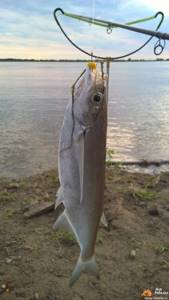
In autumn and spring, large schools migrate; it is at this time of year that commercial fishing is popular. To find a place, you need to know the preferences of this fish. Schools do not come close to the shore, so promising places can be found on shallows or bottom elevations remote from the shore, at the interface between currents, and near riffles in wide expanses of water.
Due to the sharp decline in numbers, areas where this fish is considered an endangered species, fishing is prohibited and is closely monitored by the authorities.
Highly appreciated by gourmets for its excellent taste. There are many dishes made from this fish, which must be cleaned of scales and entrails before eating. Chekhon is dried, dried and stewed. One minus is increased bonyness.
In case of individual protein intolerance, people suffering from allergies should not eat it. Those suffering from the digestive system are recommended to consume it stewed and baked.
Age and size
At maturity, this fish reaches a length of 60 cm and weighs up to 1.5 kg (usually 400-600 g). In the third or fifth year of life, after full maturity, the fish spawns from May to June in water with a temperature of 20-23 degrees. The eggs have a non-sticky structure and float freely in the water. Chekhon fry feed mainly on zooplankton, as well as terrestrial insects and their larvae.
Chekhon reaches sexual maturity on average at 3-4 years. In the southern regions, fish become sexually mature earlier - at 2-3 years, and in the northern regions, on the contrary - at 4-5 years. The average body length of a sexually mature specimen of sabrefish is 15-20 centimeters. Also, depending on the area, there are differences in spawning time and method of spawning. So in the southern regions, spawning occurs earlier, around April - May, and the female spawns eggs in portions in two batches. And in the northern regions, spawning occurs in May-June and the eggs are released at the same time. But general similarities still exist. The average water temperature in the reservoir during spawning should reach 15-20 degrees Celsius. Chekhon finds a place for spawning with a gentle current and a depth of about 1.5-6 meters.
The length of saberfish is usually no more than 20-30 cm and weighs 150-200 g. And only a few are up to 50 cm and weigh 800-900 g.
The spawning process is quite quiet. The swept caviar has a sticky shell and a diameter of 1.5 millimeters and settles to the bottom. After fertilization, the eggs swell and increase in volume. Now its diameter is 3-4 millimeters. The fertility of one female is 30-150 thousand eggs, depending on the age, size of the female and the area where the saberfish lives. The eggs ripen in 2-4 days, depending on the ambient temperature, that is, the water in the reservoir. Newly hatched sabrefish larvae have a body length of 5 millimeters, but they grow and develop quickly and initially feed on their yolk. And when they reach ten days of age, they switch to plankton and feed exclusively on it. Until sexual maturity, juvenile sabrefish grow at a rapid pace, and then development and growth slows down significantly. Before spawning, spawning males and females feed little, but after spawning they begin to feed heavily. Feeding mainly occurs in the morning and during the day, but especially hungry ones can go hunting at night.
What does saberfish eat?
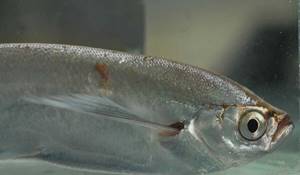
Photo: Chekhon in Russia
The sabrefish goes out hunting from the very morning and in the evening; the fish likes to have a snack:
- zooplankton;
- fish fry;
- flying insects (mosquitoes, beetles, dragonflies);
- insect larvae;
- minnows;
- roach;
- bleak;
- caviar;
- worms.
When it gets sharply cold, saberfish are very reluctant to go out to feed, and may even refuse to feed for a while. The same thing happens during the spawning period. But when the mating season comes to an end, the saber fish begins to eat incredibly. When hunting, the fish swims between the fry in complete calm, without showing any aggression, and then, with a sharp and lightning-fast exit, attacks the prey, dragging it into the water column.
If we talk about fishing, here fishermen use a whole range of different baits to catch the coveted saberfish. Among the baits, maggots, grasshoppers, bloodworms, dung and earthworms, flies, mayflies, dragonflies, gadflies, live bait, etc. are often used. The menu of young fish contains mainly plankton and larvae, insects falling into the water. Chekhon has one interesting feature: when it is saturated, it sinks into the depths.
Interesting fact: Chekhon is able to catch insects circling above the water right on the fly; the fish jumps out of the water column, grabbing its snack and loudly plopping back home.
Lifestyle
Chekhon's lifestyle Chekhon lives in freshwater rivers, lakes and reservoirs.
Can create anadromous and habitable life forms in the seas. Prefers deep and wide areas of rivers and lakes. It can rarely be found on the surface of the water. Even more rarely, she jumps out of the water. You can only notice her doing this activity in the hot season, when a flock of insects is circling over the water. Then the saberfish can jump out to feast on fresh insects. Chekhon is a very active and mobile fish, lives in schools and prefers a sedentary lifestyle. The flock lives in one area of the reservoir, where during the daytime it leads an active lifestyle and is in search of food, and at night it hides in secluded places or lies in uneven areas at the bottom of the reservoir. Chekhon can live in a section of a reservoir at a depth of up to 30 meters. Sometimes sabrefish can be found on shallows with a strong current, but sabrefish try to avoid dense thickets and places with vegetation. In autumn and spring, you can see large flocks in which sabrefish gather and migrate. It is at such times that commercial fishing for this fish is most relevant. With the onset of cold weather, the activity of saberfish noticeably decreases, and it begins to look for holes for wintering. During the cold season, sabrefish spend their time at the bottom in holes and various bottom irregularities. The diet of saberfish includes both animal and plant foods.
When young, fish mainly feed on zooplankton and phytoplankton, and with age, insects, larvae, worms and juvenile fish become their main source of food. In the summer, the saberfish jumps out of the water to catch insects and grabs them in flight. Hunt for young and inexperienced sabrefish in the following way. She often swims with her prey in a school, and then with a sharp movement pounces on the victim and goes to the bottom. After some time, the saberfish reappears in this flock and begins to look for another victim. The sabrefish itself is a lively fish and not a timid fish; it attacks its prey quickly and greedily. With the same character, sabrefish are caught on a hook, so the bite of sabrefish is always sharp and clearly visible. The saberfish feeds mainly during the daytime, and at night it hides in its shelters, mainly at the bottom of the reservoir.
Photo of sabrefish
Read here Hungarian lamprey - where it lives, how to catch it, and what bait to use. Fishing methods and cooking features (115 photos + video)
Help the project, share on social networks 

0
Fishing for sabrefish
Catching sabrefish The most optimal time for catching sabrefish is spring and autumn - the time of its migration, when the fish gather in huge schools.
At the same time, the saberfish begins to zhor - the most intensive feeding. In the spring it prepares for spawning, and in the fall for winter. This is a great sign for anglers. As for the time of day, the best option is morning and daytime, since saberfish lead a predominantly diurnal lifestyle and practically do not feed at night. So it is not possible to catch saberfish at night. For fishing, it is better to choose deep and spacious places in the reservoir, since this fish can rarely be found in cramped and shallow places, as well as with dense vegetation. You should also pay attention to the condition of the water and bottom. The bottom should be sandy and the water clean. The baits used for catching sabrefish vary depending on the season of the year. The saber fish bites best on worms and maggots, but in summer you can use insects such as flies, dragonflies, and grasshoppers and catch them on the surface of the water. In the fall, it is good to catch other fish with juveniles, and you can also deceive sabrefish with pieces of polystyrene or foam rubber, which the fish will mistake for a worm or larva. Some fishermen use attractive spoons and wobblers as bait, and not without success.
For greater interest and excitement, use such gear as a float rod, fly fishing tackle, elastic band and spinning rod. When choosing gear, you should pay attention to its quality and equipment. So the length of the rod should be 4-6 meters, the diameter of the fishing line should be 0.2 millimeters. For a leash, the fishing line used is thinner - 0.15-0.17 millimeters. The choice of hook depends on the size and quality of the bait, but most often they use No. 3-5.
The sabrefish bites quickly and confidently swallows the bait. When biting, the float abruptly goes under the water and to the side. Catching saberfish is not difficult, but you still need to be careful and careful. They land the fish carefully and slowly, gradually pulling the line towards themselves. The fish is fished on the surface of the water, and not lifted above the water, as it can jump off (siberian fish have very thin lips, and they can tear under the weight of the fish). If everything is done carefully and without unnecessary noise and fuss, then in the same place you can catch a sufficient number of fish from one school. But if you startle the flock, you will have to move to another place. Also, you should not be zealous and fish for a long time in one place if there is no bite for a long time. The flock moves quickly, so the best option would be to catch sabrefish from a boat. Only for this you will have to use oars, and not a motor, which can scare away all the fish. When catching sabrefish, a little bait won’t hurt, although you can do without it.
Lures for saberfish
According to the advice of experienced fishermen, it is worth experimenting and using different baits and lures for sabrefish. For successful fishing, you need to know the preferences of fish in a certain period. In spring and autumn, baits of animal origin are suitable for catching sabrefish: maggots, flies, bloodworms and worms.
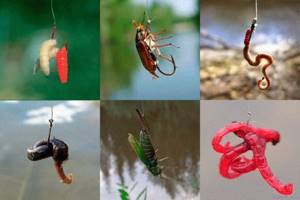
It is better to choose from plant-based attachments: various cereals, dough and steamed corn. A win-win option is catching saberfish using bloodworms. In summer, fish attack butterflies, insects, beetles and grasshoppers. You can also use different stationary fishing rods and baits, since saberfish are not a very picky fish.
Chekhon in food
Chekhon is a low-calorie product that is most useful in various diet menu dishes. The calorie content of sabrefish is 88 kcal, and the fish also contains 2 g of fat and 17 g of protein.
Chekhon is a fish of medium fat content and contains a large amount of useful protein substances. The fat content of the fish depends on its type, so the Volga saberfish has low-fat meat, and the Don saberfish is a larger and fattier fish.
The meat of this fish contains a large amount of useful substances and microelements, such as molybdenum, chromium, magnesium, calcium and phosphorus. These substances have a beneficial effect on metabolism, improve the processes of growth and strengthening of bones, and help remove harmful acids from the body.
Chekhon contains nickel and fluorine, which prevent skin pigmentation disorders, form tooth enamel, have a positive effect on the nervous system, improve hair and nail growth, and also promote cell regeneration.
Regular consumption of saber fish improves metabolism and normalizes blood sugar and cholesterol levels.
Features of character and lifestyle

Photo: Chekhon from the Red Book
We have already found out that some fish are classified as semi-anadromous; most of the time they are stationed in the estuarine areas, which are rich in various foods. The other part of the saberfish is sedentary, practically no different from the previous one. Chekhon leads a collective lifestyle, preferring a gregarious existence. This fish spawns only in fresh water bodies; sabrefish often travel hundreds of kilometers to reach spawning grounds.
Chekhon chooses reservoirs with a relief bottom covered with a large number of holes. The fish spend the night in them, wait out bad weather and frosty days, and hide from the intense heat. The saber fish are most active in the late morning, afternoon and early evening. It depends on the characteristics of her diet. The fish hunts for fry or insects in the surface or middle water layers. The saber fish can be called cautious; it rarely swims into the coastal zone and tries to avoid shallow water. This fish feels free and comfortable at a depth ranging from 5 to 30 meters; here it can relax and be more carefree.
The presence of rapids and riffles on the river does not at all frighten the sabrefish; on the contrary, it adores such places, because it has excellent maneuverability and stability, with deft throws snatching various insects, fry and invertebrates from the rapid water flow. With the arrival of September, the saber fish begins to eat intensively, preparing for the winter, then it goes to the depths. It is worth adding that even in the cold winter, the fish continue to be active and are caught directly from under the ice.

